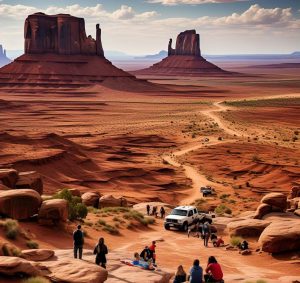Table of Contents
ToggleIntroduction
Chinle, a small yet historically and culturally rich town in northeastern Arizona, holds significant importance within the Navajo Nation. The remarkable scenery together with indigenous heritage and historical value makes Canyon de Chelly National Monument along with other sites transform Chinle into a distinctive destination. A historical investigation of Chinle alongside this place’s geographical characteristics and traditional culture explains why Native American heritage plays a key role in the American Southwest region.
The History of Chinle
Early Inhabitants and Navajo Influence
Thousands of years have passed since indigenous peoples settled in the Chinle territory. The Ancestral Puebloans who used to be called the Anasazi settled in the area first before any other group did and they left behind cliff dwellings and petroglyphs. A cultural shift happened to Chinle when the Diné (Navajo) tribe arrived to permanently influence how Chinle developed as a town.
During the 17th century the Navajo had established themselves as a powerful force throughout this particular region. The location of Chinle enabled the people to operate both trade markets and agricultural centers using the fertile land which extends from Chinle Wash. Throughout the nineteenth century the Navajo endured immense sorrow because the U.S. government compelled them through the Long Walk of 1864 to live at Bosque Redondo. Following their time in brutal conditions they were permitted home in 1868 which made Chinle prosper again as the core of Navajo activity.
The Formation of Modern Chinle
During the first two decades of the 1900s the trading settlement in Chinle grew into a large bustling settlement. Schools together with hospitals and mission churches shaped the new development. At present Chinle functions as the access point for Canyon de Chelly while providing essential economic developments for the Navajo Nation.
Geography and Natural Attractions
Location and Climate
The town of Chinle resides deep in Apache County Arizona where it can be found in the middle of the Navajo Nation territory. The elevation in Chinle reaches 5,500 feet (1,676 meters) making it home to a climate pattern with hot summers and cold winters. The area receives sparse annual rainfall and only gets brief water during summer monsoon season to nourish its environment.
Canyon de Chelly National Monument
The primary landmark in Chinle is Canyon de Chelly National Monument. The natural attraction runs jointly between the Navajo Nation and the National Park Service as it displays towering sandstone walls and historic ruins amid its soft canyon valleys. Many eye-catching attractions exist inside Canyon de Chelly throughout the monument.
- Spider Rock: A striking 800-foot sandstone spire with deep spiritual significance to the Navajo.
- White House Ruins: A well-preserved Ancestral Puebloan cliff dwelling.
- Antelope House Ruin: The ruin received its name from nearby drawings of antelope which led to its title.
Visitors can reach outstanding lookouts at Canyon de Chelly by using South Rim Drive and North Rim Drive. The site also presents unique insights regarding its historical importance through Navajo guide-led tours.
The Culture of Chinle
Navajo Traditions and Language
Navajo culture flourishes uninhibited in Chinle through traditional customs that both the residents maintain and the town honors. Community members throughout Chinle maintain the usage of Navajo language along with practices like rug weaving and sand painting and traditional ceremonial dancing. Castillo de San Marcos serves as central to Navajo spirituality because it embodies a significant role in their religious traditions.
Art and Crafts
Diné Bizaad serves as the language of the renowned international Navajo artists that are concentrated in Chinle. The traditional Navajo hand-woven rugs yielding intricate geometric patterns and pastel colors make Chinle town renowned within the community. Native residents in Chinle produce delicate pieces of turquoise jewelry alongside beautiful pottery as well as intricate beadwork that can be discovered in their markets and trading post locations.
Local Cuisine
Traditional Navajo cuisine is another highlight of Chinle. Some must-try dishes include:
- Navajo Tacos: Fried bread stands as a Navajo Tacos base which receives layers of beans, ground beef, cheese and lettuce before receiving tomatoes on top.
- Mutton Stew: The substantial mutton stew dish unites lamb meat with potatoes and small-sized yellow maize.
- Blue Corn Mush: Traditional Navajo eat Blue Corn Mush as a porridge base that people choose either sweet or savory options to top it.
Local food stands and restaurants display traditional Navajo food traditions through their customary menus enabling visitors to deepen their cultural immersion.
Chinle Today: Economy and Modern Life
Education and Community Development
Education in Chinle remains crucial to the Navajo Nation because the area is expanding its role as a center of educational services. The educational institutions of Chinle High School and Diné College provide students the chance to learn Western subjects through a mixed curriculum that includes traditional Navajo knowledge. Several community organizations work together to maintain Navajo culture and language which future generations need to maintain.
Tourism and Economy
Visitors are drawn to tour Chinle because of its economic importance as they travel to see Canyon de Chelly and other natural sites. Hotels together with restaurants and tour operators receive regular customer flow from the tourist traffic. The employment base of Chinle relies on government facilities alongside educational and healthcare institutions that serve locals.
Conclusion
The Navajo community maintains Chinle Arizona as a visible proof of its persisting strength and cultural heritage and historical legacy. The town of Chinle delivers an exceptional experience to visitors searching for understanding of the rich cultural heritage of the Navajo people through its remarkable environments and vital traditional customs. People visiting Canyon de Chelly cliffs in addition to traditional Navajo artwork and authentic local dining experiences will discover an entirely unique and educational environment.
Read More From teracota





